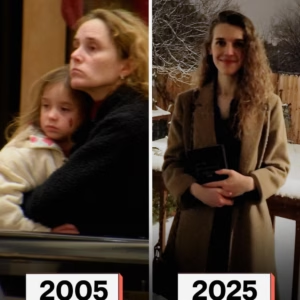When Dirty Dancing hit theaters in August 1987, no one involved in the small, low-budget film could have predicted the cultural earthquake it would create. The story of a young woman finding love and confidence at a Catskills resort became an instant classic, and its stars, Patrick Swayze and Jennifer Grey, became household names. For Swayze, it launched a career filled with blockbuster roles and heartthrob status. For Jennifer Grey, however, it marked both the peak of her fame and the beginning of a tragic personal struggle that would change her life forever.
Grey, then just 27, seemed destined for stardom. Her portrayal of Frances “Baby” Houseman — vulnerable yet fiercely independent — resonated deeply with audiences. Critics praised her for grounding the film’s fantasy in something raw and believable. She earned a Golden Globe nomination and found herself on the brink of Hollywood’s A-list. But just as the movie was about to premiere, a horrific event derailed everything.
In the summer of 1987, Jennifer and her then-boyfriend, actor Matthew Broderick, took a vacation in Ireland. Broderick, fresh off his own success with Ferris Bueller’s Day Off, was driving a rental car when tragedy struck. Traveling on the wrong side of the road, their car collided head-on with another vehicle. The two passengers in that car — a mother and her daughter — were killed instantly.
Grey suffered only minor physical injuries, but the emotional toll was devastating. “The day before the world saw me as this bright, rising star, I was in a car accident that destroyed lives,” she later told People magazine. “The juxtaposition of that — of being celebrated while someone else’s family was grieving — it broke something in me.”Family games
The timing made the pain almost unbearable. Just days after the crash, Dirty Dancing premiered to rave reviews and massive crowds. While the rest of the cast celebrated, Grey withdrew completely. “It didn’t feel right to be the toast of the town,” she told The Daily Mirror. “I felt like I had blood on my hands. I couldn’t reconcile being in mourning and being in the spotlight at the same time.”
Her survivor’s guilt would haunt her for years. “My ambition and my head were never the same,” she admitted. “I lost my sense of joy.” For someone raised in a show business family — her father, Joel Grey, was a Tony and Oscar-winning performer, and her mother, Jo Wilder, was an actress and singer — that loss cut deep. Acting had always been her refuge, but after the accident, it became a reminder of the life she no longer recognized.
Before the tragedy, Grey’s path had seemed charmed. Born in New York City in 1960, she grew up immersed in art and performance. She trained in dance and acting at the Dalton School and later at the Neighborhood Playhouse, working tables to pay rent while chasing roles. Her early credits included commercials — most notably one for Dr. Pepper — and small parts in films like Reckless (1984) and The Cotton Club (1984). By the time she appeared opposite Swayze in Dirty Dancing, she had the poise of a veteran and the freshness of a newcomer.
But fame never came easy for her. The media attention following Dirty Dancing — combined with the lingering trauma of the accident — became suffocating. She began to retreat from Hollywood, taking sporadic roles in smaller projects. Her career stumbled further after she decided to undergo plastic surgery in the early 1990s, a choice that became one of the most infamous examples of celebrity transformation gone wrong.
“I entered the operating room as a celebrity and left anonymous,” she said years later. The two nose jobs drastically altered her appearance. “It was like being in witness protection. I’ll always be that once-famous actress that nobody recognizes because of a nose job.”
In an industry obsessed with image, the surgery effectively reset her career — but not in the way she hoped. Casting directors no longer recognized her. Roles dried up. She faded from the public eye, appearing only occasionally, such as in a 1995 episode of Friends and a few independent films.
Still, Jennifer Grey refused to let her story end in tragedy. In 2010, she stepped back into the spotlight — not as an actress, but as a contestant on Dancing with the Stars. It was a full-circle moment: the star of Dirty Dancing returning to the stage, confronting both her past and her fear. Despite chronic pain from a long-undiagnosed spinal injury, she performed with grace and emotional honesty, eventually winning the competition. “It felt like I’d been starving for 23 years,” she said afterward. “And suddenly, I got to eat again.”
That win reignited something in her — not just career momentum, but confidence. “For so long, I let fear dictate my choices,” she told People. “But when I danced again, I remembered the part of me that wasn’t afraid. The part that just wanted to live.”
Since then, Grey has quietly rebuilt her life and career on her own terms. She’s appeared in the Amazon comedy Red Oaks and the film Untogether alongside Jamie Dornan and Jemima Kirke. In interviews, she’s candid about aging in Hollywood, about self-acceptance, and about the long road to healing from trauma. “I’ve stopped wishing for a different past,” she said. “Now, I just want to be present.”
Her story is one of resilience — not a Hollywood fairytale, but something more grounded and human. She’s the first to admit that her career didn’t turn out the way she once imagined. But she’s also clear that peace, not fame, was what she needed most. “I thought success would fix everything,” she reflected. “But it doesn’t. What fixes you is forgiving yourself.”
Today, at 63, Jennifer Grey has found a quiet kind of fame again — not through headlines, but through enduring affection from fans who grew up with Dirty Dancing. For millions, she’ll always be “Baby,” the girl who learned to trust herself enough to take the stage. But the real Jennifer Grey is someone deeper — a woman who faced grief, regret, and reinvention, and somehow came through with her soul intact.
When asked recently whether she ever considered a full Hollywood comeback, Grey smiled. “I don’t need to go back,” she said. “I never really left. I just had to find myself first.”
Her words land with the same sincerity that made audiences fall in love with her decades ago. After all, the magic of Jennifer Grey was never in how she looked — it was in how she made people feel. And that, no surgery or tragedy can ever erase.





